
Planned construction of a regional airport in Qaqortoq, in southern Greenland, can go ahead after a contractor to build the runway was chosen last week. A contractor to build the runway, terminal and other structures at the Qaqortoq airport was originally to have been chosen in May of 2020. Initially delayed, the first tender wound up being postponed in September 2020, after it emerged that all of the offers received by Kalaallit Airports Domestic would have put the project over its 699 million kroner (€94 million) budget.
Pennecon Heavy Civil, a Canadian firm, will carry out the work. It is due to begin work this spring and complete the runway in 2025. A tender to find a contractor to build the airpot buildings will be held later this year. According to Kalaallit Airports, the nationally controlled firm that will operate the airport and is responsible for having it built, Pennecon Heavy Civil submitted what would have been a winning bid in the second tender in June of last year, but because it, like all of the other bids submitted were still over budget, that tender was cancelled and the legislature asked either to kick in more money or scale back their ambitions.
They chose the former, deciding to find the extra 400 million kroner needed to build the 1,500m runway it approved in 2017 as part of a 3.6 billion kroner deal to establish a regional airport in southern Greenland’s largest town and to makes upgrades to two other airports to allow them to serve as international airports.
The project is the most expensive in Greenland’s history. Supporters justify its cost on the argument that the airports will pay for themselves in the form of increased mobility for people living in Greenland and by making it easier for travellers to visit, but not everyone agrees the plan is the best way to structure the country’s network of airports.
Qaqortoq, for its part, will replace the airport in the remote hamlet of Narsarsuaq as the primary gateway in southern Greenland. Few deny the wisdom of this: established during the Second World War by the US military as a stopover for aeroplanes making transatlantic flights, Narsarsuaq’s remote location requires passengers traveling on to Qaqortoq to board a connecting helicopter or ferry. Pilots, meanwhile, consider it a notoriously difficult place to land.
Because an airport in Qaqortoq would mean shorter travel times for passengers, and thus saved time, the additional cost for the 1,500m runway, would actually be 292 million kroner during the airport’s lifetime, the legislature was told in a report it commissioned Deloitte to carry out in advance of the third tender last year. However, other options lawmakers rejected would have been a better value, it said. Deloitte concluded that the best compromise in terms of interoperability and long-term viability would have been the 1,200-metre runway. The 1,500-metre runway, on the other hand, made least economic sense.
Interoperability is an evaluation of how well the airport can be incorporated into Greenland’s existing network of travel infrastructure and whether the types of aeroplanes used by airlines that service Greenland can land there. Long-term viability is a prediction of how well the airport can be expected to hold up in the face of developments in aerospace technology and the travel industry.
Kevin McGwin, PolarJournal
More about this topic





